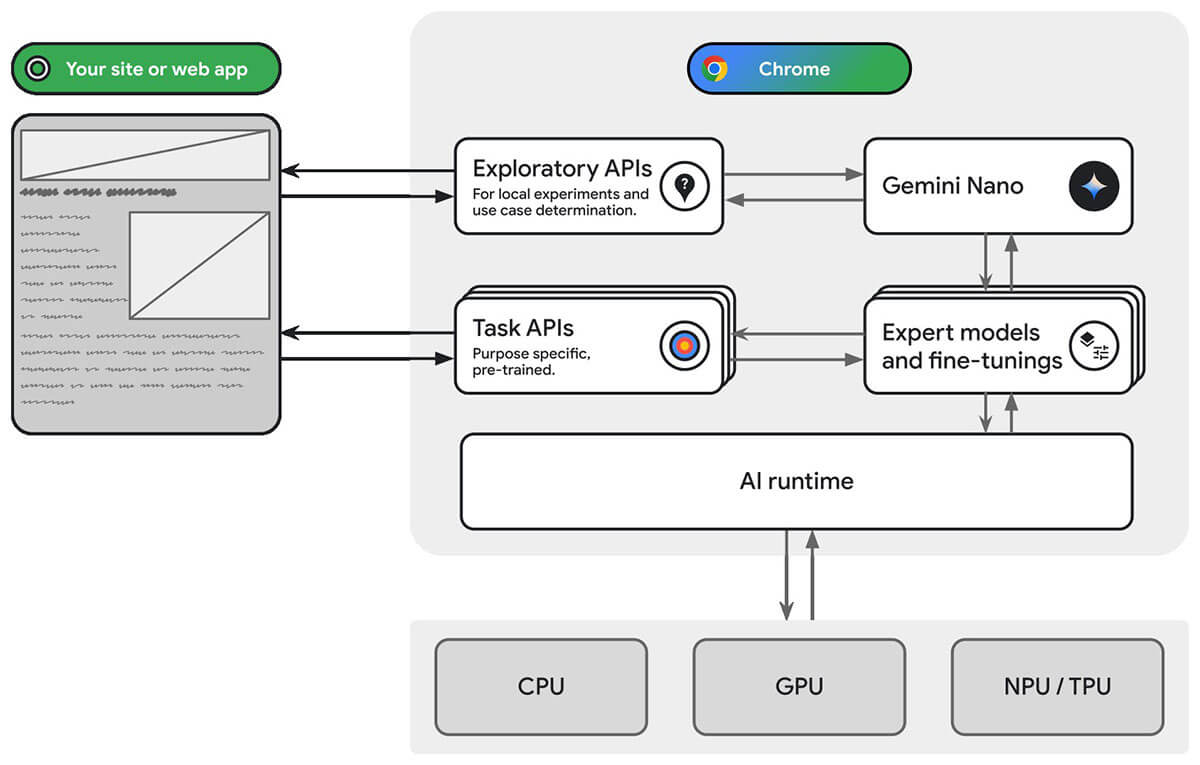
We often hear about the potential of AI to revolutionize various aspects of our lives. But there's a particular development that's caught my attention recently: Built-in AI in web browsers. It's a concept that seems simple at first glance, but the more you think about it, the more profound its implications become.
The idea is straightforward: integrate AI models, including large language models (LLMs), directly into web browsers. Google Chrome is leading this charge with Gemini Nano, a compact version of their Gemini family of LLMs designed to run locally on most modern computers. But is this really as transformative as it sounds, or is it just another tech buzzword?
To answer this, we need to look deeper at what Built-in AI actually means and how it differs from our current paradigm of web interaction.
At present, when we use AI-powered features on the web, we're typically relying on server-side solutions. This is especially true for generative AI, where models are often too large to run efficiently on a user's device. But this approach has its limitations. It requires constant internet connectivity, can raise privacy concerns, and may introduce latency that hampers user experience.
Built-in AI proposes a different model. By integrating AI capabilities directly into the browser, it promises to overcome these limitations. But is this promise real, or is it just a more complicated way of doing what we already do?
The difference, I believe, lies in the nature of the interaction between user and AI. With server-side AI, there's always a disconnect – a moment where your data leaves your device, gets processed elsewhere, and returns. It's like having a conversation where every response requires your partner to leave the room and come back. Built-in AI, on the other hand, is more like having that partner right there with you, able to respond immediately and privately.
This immediacy and privacy could fundamentally change how we interact with the web. Imagine reading an article and being able to get an instant summary, translation, or answers to questions about the content – all without sending your data to a remote server. Or consider writing an email, with your browser offering real-time suggestions and improvements, tailored to your personal style and the context of your message.
But the potential goes beyond just enhancing existing tasks. Built-in AI could enable entirely new ways of interacting with web content. Websites could use on-device AI to customize their interfaces and content based on your preferences and behavior, without needing to store or process your personal data on their servers. This could lead to a web that's not just more intelligent, but also more personal and private.
However, like any significant technological shift, Built-in AI comes with its own set of challenges. The most obvious is the technical hurdle of running complex AI models efficiently on a wide range of devices. While Gemini Nano is designed to be compact, it's still a substantial piece of software to integrate into a web browser.
There's also the question of model updates and improvements. One of the advantages of server-side AI is that improvements can be rolled out instantly to all users. With Built-in AI, there needs to be a mechanism for regularly updating the models without disrupting the user experience or bloating the browser.
Privacy, while potentially enhanced by on-device processing, also presents new concerns. How do we ensure that the AI models themselves don't inadvertently leak personal information? And how do we prevent malicious websites from exploiting these powerful on-device capabilities?
These challenges are significant, but they're not insurmountable. In fact, they're reminiscent of the challenges faced in the early days of the web itself. Just as we figured out how to make complex web applications run smoothly in browsers, I believe we'll find ways to make Built-in AI work effectively and securely.
For developers, Built-in AI represents both an opportunity and a paradigm shift. It offers the potential to create more intelligent, responsive web applications without the need for complex server-side AI infrastructure. But it also requires a new way of thinking about web development, where AI capabilities are a fundamental part of the browser environment rather than an external service to be called upon.
The relationship between Built-in AI and server-side AI is likely to evolve into a hybrid model. Some tasks will be better suited to on-device processing, while others will still benefit from the power and flexibility of server-side AI. The skill for developers will be in knowing how to balance these approaches to create the best possible user experience.
As we stand on the brink of this potential shift in web technology, it's worth considering the broader implications. Could Built-in AI lead to a more decentralized web, where powerful capabilities are distributed across millions of devices rather than concentrated in the data centers of a few large companies? Might it change our expectations of what a web browser is and does, transforming it from a simple window onto the internet into an intelligent assistant that helps us navigate and interact with online content?
These are open questions, and their answers will depend not just on technological development, but on how we as developers, users, and societies choose to shape and use these new capabilities.
In the end, the true test of Built-in AI will be in its ability to solve real problems and enhance our online experiences in meaningful ways. If it can do that while preserving privacy and security, then it may indeed represent the next significant evolution of the web.
The web has always been about connecting people and ideas. With Built-in AI, we're not just connecting – we're creating, understanding, and innovating in ways we've never seen before. It's an exciting prospect, and I, for one, am eager to see how it unfolds.
References:
